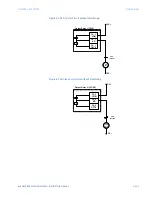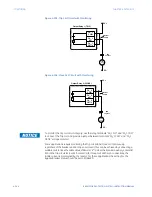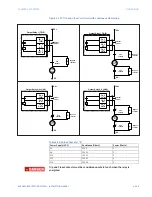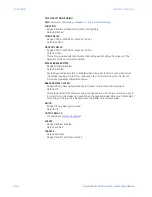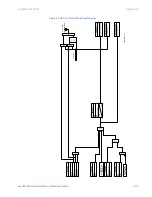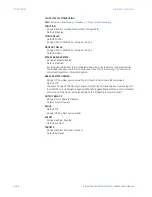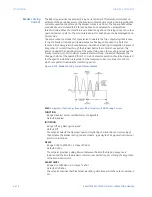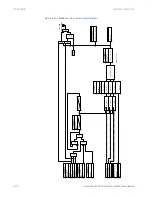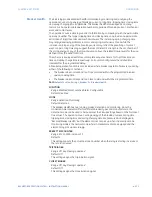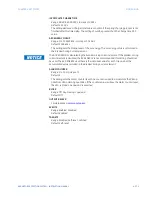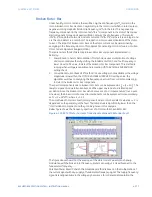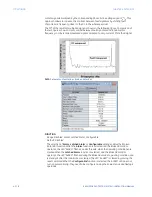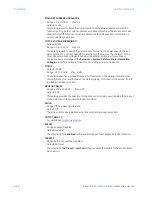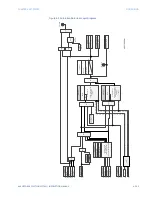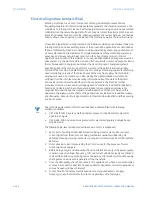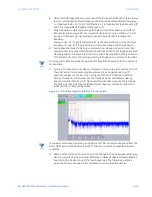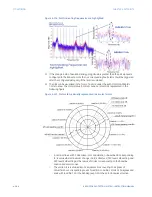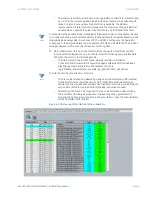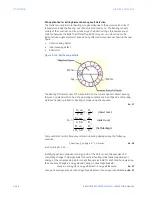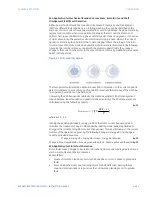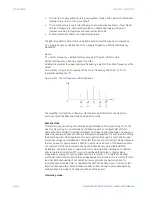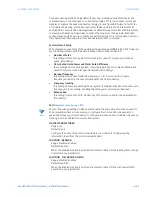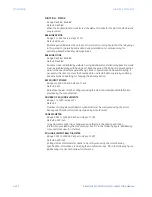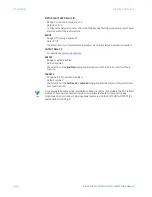
CHAPTER 4: SETPOINTS
MONITORING
869 MOTOR PROTECTION SYSTEM – INSTRUCTION MANUAL
4–277
Broken Rotor Bar
Under healthy rotor conditions, there will be only the slip frequency (s*f
s
) current in the
rotor. A broken rotor bar creates an asymmetry in the rotor circuit which in turn creates a
negative rotating magnetic field at slip frequency (-s*f
s
) in the rotor. This negative slip
frequency component in the rotor creates f
s
*(1-2*s) component in the stator. This causes
electromagnetic torque and speed oscillation at twice the slip frequency. This results
infs*(1+2*s) and other harmonics in stator current at fs*(1+2*k*s), where k is an integer and
s is the slip. A defect in a rotor bar of an induction motor causes modulation of the stator
current. The impact of broken rotor bars on the stator current can be determined by
analyzing in the frequency domain. This approach to detecting rotor bar failures is called
Motor Current Signature Analysis (MCSA).
There are two methods of detecting Broken Rotor Bar component implemented in
869 relay:
1.
Power Based Coherent Demodulation: This technique uses multiplication of voltage
and current samples thereby shifting the fundamental to DC and fault frequency to
lower closer to DC value, to detect the broken rotor bar component. This method is
running when voltage is available and is meeting MOTOR VOLTAGE SUPERVISION
setting check.
2.
Conventional current based FFT method: In case voltage is not available or the voltage
magnitude is lower than the MOTOR VOLTAGE SUPERVISION setting value, the
algorithm switches to analyzing the frequency spectrum from current samples only,
to detect the broken rotor bar component.
The spectral components due to broken rotor bars can be expressed as: f
b
= (1 ± 2s)f
1
. The
lower component is due to broken bars, and the upper one is due to a related speed
oscillation. Since the broken rotor bar disturbances are of an “impulse nature” (not a pure
sine wave), the broken rotor bar spectral components can be expressed more accurately
as: f
S
= (1 ± 2k*s)*f
1
, where k = 1,2, 3…
The amplitude of harmonic spectral components due to rotor bar defects, where k >= 2, is
dependant on the geometry of the fault. Their amplitude is significantly lower than the
“main” sidebar component and they can be ignored in this analysis.
Below figure shows the frequency spectrum of a Motor with Broken Rotor Bar:
Figure 4-113: EFT of Stator Current of Induction Machine with Rotor Bar Fault
The figure above shows that the envelope of the stator current waveform is heavily
modulated with the broken rotor frequency present at nearly ±12 Hz with respect to the
fundamental frequency.
Patented Power Based Coherent Demodulation method is based on the multiplication of
the current signal with any supply of fundamental frequency signal. The supply frequency
signal is readily available in the voltage signal. Hence, for coherent demodulation, the
Содержание 869
Страница 10: ...VIII 869 MOTOR PROTECTION SYSTEM INSTRUCTION MANUAL ...
Страница 48: ...1 38 869 MOTOR PROTECTION SYSTEM INSTRUCTION MANUAL FOR FURTHER ASSISTANCE CHAPTER 1 INTRODUCTION ...
Страница 78: ...2 30 869 MOTOR PROTECTION SYSTEM INSTRUCTION MANUAL ELECTRICAL INSTALLATION CHAPTER 2 INSTALLATION ...
Страница 127: ...CHAPTER 3 INTERFACES SOFTWARE INTERFACE 869 MOTOR PROTECTION SYSTEM INSTRUCTION MANUAL 3 49 ...
Страница 129: ...CHAPTER 3 INTERFACES SOFTWARE INTERFACE 869 MOTOR PROTECTION SYSTEM INSTRUCTION MANUAL 3 51 ...
Страница 538: ...4 406 869 MOTOR PROTECTION SYSTEM INSTRUCTION MANUAL TESTING CHAPTER 4 SETPOINTS ...
Страница 578: ...6 22 869 MOTOR PROTECTION SYSTEM INSTRUCTION MANUAL FLEXELEMENTS CHAPTER 6 METERING ...
Страница 592: ...7 14 869 MOTOR PROTECTION SYSTEM INSTRUCTION MANUAL CLEAR RECORDS CHAPTER 7 RECORDS ...

